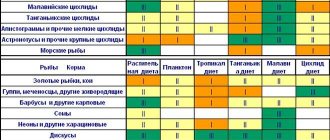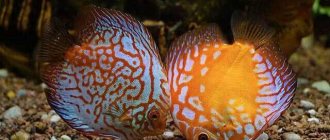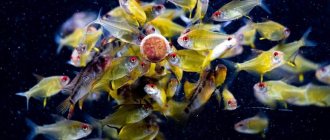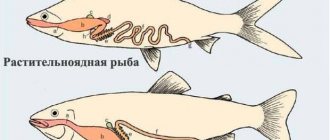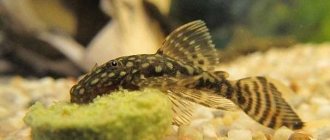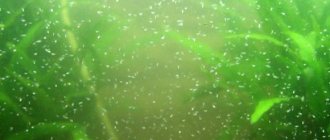An aquarium at home is a source of positive emotions and peace. The therapeutic effect of contemplating the underwater kingdom and the leisurely life of its inhabitants is worth taking on the trouble of caring for it. By observing fish, you can learn to understand their desires and states. Therefore, when you discover a depressed state of your pets, you need to be wary and understand the reasons. One of the first possible ones is improper nutrition and selection of food. We will tell you how to choose food and prevent your fish from getting sick in our review. The editors of the Yanashla website present a rating of the best fish food for 2021, selection criteria, recommendations for feeding aquarium fish and reviews from aquarists.
How to choose the right food for aquarium fish
Today there are many treats for underwater inhabitants. The main task is to find out what kind of food is suitable for the fish you have.
Feeds that promote rapid growth must have a large amount of protein. Energy is provided by fats and carbohydrates. To strengthen the immune system and form the skeleton, food must contain a sufficient amount of vitamins and minerals.
To keep your fish from getting sick, you should diversify their menu. It is better to alternate 2-3 products made from insect larvae, small pieces of fresh vegetables or special vitamin preparations - it depends on the type of fish.
If the fish eat the treat quickly and with appetite, rest assured that the ingredients were selected correctly. But you shouldn’t overfeed your pets. Adults should consume 2-5% of their weight per day, fry - up to 1/3.
Top 4 – Aulophorus (water snake)
Aulophorus are worms, close relatives of the tubifex. It is also found in freshwater bodies of water in temperate and tropical climates. This is a high-calorie food for raising fry and for feeding fish.
Aulophorus, unlike tubifex, is easy to breed at home. But there is a drawback - a very strong smell. To reduce the smell, the worms need to be washed regularly.
To breed Aulophorus, take any plastic container into a container. It is more convenient to take containers that are low and wide. A sponge or foam rubber, well moistened with water, is placed on the bottom.
The sponge is filled with water to about 2-3 cm: the water should lightly cover the material so that it remains moist. Worms are laid out on top and food is placed.
You can feed Aulophorus with oatmeal, oatmeal, vegetables (carrots, zucchini, melon), and nettles. Aulophorus eats regular oatmeal best.
The worm is washed daily: the water is drained and new water is added. New food is added.
The drained water can be filtered - it will contain aulophorus, which can be fed to the fish.
In a day you can get up to 300 grams of growth in a container of 20-25 liters.
In addition, along with aulophorus, ciliates are also excellently bred on oatmeal. Therefore, food can be obtained in this way for the smallest fry.
Types of food for aquarium fish
To choose high-quality, and most importantly, suitable food for your pets, you need to understand the assortment:
Dry food for aquarium fish and its types
They are inexpensive, economical to use, and easy to store.
Types of dry food for aquarium fish:
- tablets with plant or animal components immediately sink to depth under their own weight. Suitable for bottom fish (catfish of various species);
- The flakes are suitable for all breeds, but due to their low nutritional value they are used as a supplement. The flakes do not sink, so they feed on fish that can grab food from the surface (Guppies, Neon, Barbus, etc.);
- The granules are universal, like the previous food. They can float or sink (depending on the composition). They swell in water. Before feeding, they need to be soaked for 10 minutes so that they do not increase in size after swallowing and cause digestive problems;
- microfeeds are sold in the form of dust and are food for fry. They heavily pollute the aquarium (require frequent water changes).
Live food for aquarium fish
Live food contains large amounts of protein, which promotes growth and reproduction. You should be careful about storage and purchase from trusted suppliers so as not to introduce infection into the aquarium.
Types of live food for aquarium fish:
- bloodworm;
- coretra;
- tubifex;
- daphnia;
- Artemia;
- frozen food is the same types (as listed above), but with the addition of ciliates, cyclops, etc. The food is briquettes, frozen at the production stage, so it is stored for a long time without losing its beneficial properties.
Auxiliary compounds
Auxiliary compositions are necessary for fish that require increased feeding due to illness, the breeding season, or simply high activity during the day (cichlids, barbs). Also, additional formulations are suitable for fish that do not have time to eat enough with everyone during the feeding period.
Auxiliary formulations are usually made from high-protein foods: larvae, krill, crustaceans with jelly and fatty acids. Available in tablet form. But such nutrition is not typical for fry, so it is better to continue keeping them on live food.
Where and how to store fish food
Typically, dry food is sold in sealed bags or other containers. It should be stored in a cool, dry place, tightly closed in a light-proof container. You need to purchase such a quantity to use it no later than 3 months. When purchasing, pay attention to the expiration date.
Frozen food is especially popular among aquarists. They are subjected to gamma irradiation at the production stage, so they are safer for fish than their live counterparts. They should be stored in the freezer. Before feeding your pets, you need to let the food thaw under running cold water and strain.
Unfortunately, live food does not last long. It can be kept in the “warmest” compartment of the refrigerator in a plastic container for a maximum of several days. Place a damp white cloth inside so that the ends hang down. The feed is laid out in a thin layer, leveled and covered with the ends of the fabric. The container should be loosely covered with a lid. Plankton must be periodically washed in a net under running water.
Top 6 - Daphnia
Daphnia or water fleas (0.2-5 millimeters) are an ideal live food for adult fish, as many fish feed on them in their natural habitat. Daphnia easily survive in the aquarium, helping to clean it by eating microscopic food debris until they themselves are eaten. If you add them to a fry tank, they will clean the water by eating bacteria that can kill the fry while still being a source of food.
The downside is that not all types of fish eat daphnia.
The daphnia culture is placed in any suitable container and a light source is installed, natural solar or artificial. There should be a lot of light.
The compressor tube is lowered into the container and the temperature is maintained at 24 degrees Celsius. You can feed daphnia with dry yeast, soy flour, and green flowering water. A siphon is used to collect fleas for feeding.
What food is best for aquarium fish?
When selecting food, you should keep in mind that the main goal should be to help, not harm. We need a composition that does not degrade water quality. Many cheap feeds, when soaked, settle on the bottom, plants, and filters. They pollute the environment and, when decomposed, can poison it.
When choosing, you should adhere to certain rules and take into account the preferences of certain breeds.
Viviparous inhabitants of the aquarium are not very picky about food. In nature, they feed on live food, so bloodworms, tubifex, etc. are suitable. Do not forget about plant foods (dried nettle, spirulina). It is easier to purchase special mixtures that do not pollute the water. The food should not be large in order to be evenly distributed throughout the entire aquarium.
Predators, when hungry, attack each other, so the basis for them is live food (various worms, etc.). If this is not available, it is allowed to feed raw meat or fish.
Bottom-dwelling fish feed on what sinks. Their favorite treat is dry tablets. You need to feed with plant (lettuce, cucumber) and animal (bloodworm, coretra) proteins.
It is recommended for the little ones:
- live dust;
- ciliates;
- pot worms;
- nematodes;
- chopped egg yolk.
Top 7 - Grindal Worms
Grindal worms or microworms (commercially known as nematode microworms) are truly microscopic worms, they are smaller than newly hatched brine shrimp nauplii, so they are an ideal food for fry, but small fish will also happily eat them. Grindal grows up to 1-2 mm in length, the nutritional value is 10.1 g of protein and 19.5 g of fat per 100 g (the nutritional value is much lower than that of brine shrimp, bloodworms or tubifex).
The bottom of a small container is covered 1 cm with oatmeal. First, the flakes are mixed with water so that the mixture is thick enough. Yeast is sprinkled on top of the flakes and a grindal worm culture is added. One small spoon is enough to start growing microworms.
The container for growing the crop must be closed, but have holes for air to enter and moisture to escape. Store container at room temperature. The oatmeal will begin to smell yeasty and watery in a few days, and after a week you will be ready to harvest the grindal worms.
The crop can be stored and fed for several weeks before a fresh batch needs to be planted.
To collect grindal worms, the box must be placed in a warm place, for example, on a warm radiator or lamp. To escape the heat, the worms will begin to crawl up the side walls of the container.
About 15 minutes after the start of the procedure, the grindal can be collected by running a toothbrush or plastic knife along the walls of the container. The collected portion is washed into a jar of aquarium water, and then nematodes are collected from the bottom using a syringe and fed to the fish.
Grindal worms very quickly settle to the bottom and die there, so you need to feed the fry in small portions.
How long can you not feed aquarium fish?
In order for the body of aquarium pets to function normally, the feeding regime must be balanced. Many novice aquarists often overfeed their pets. Therefore, periodically you need to arrange “fasting” days. It should be taken into account that for different breeds the number of fasting days without harm to health should be different.
Cichlids, catfish and Neons cannot go more than 1 week without food. The fry require a lot of food and will not survive fasting for more than 4 days. Locarium catfish and algae eaters can go without food for up to 10 days.
The ideal solution for when you're away is an automatic feeder that can be set to specific feeding times and portion sizes. The only drawback is that it only serves dry food.
Don't forget the rule! Underfeeding is better than overfeeding.
Content
An aquarium is a decoration for an apartment. Admiring goldfish is a great pleasure.
However, aquatic creatures require certain conditions of detention:
- Appropriate temperature conditions;
- A certain area of water;
- Availability of oxygen;
- High quality food.
The short life of aquarium beauties can be further shortened if they are not properly maintained and fed.
Proper nutrition affects almost every aspect of a goldfish's life:
- Immunity;
- Appearance;
- The ability to give birth.
The assortment of zoological stores offers a wide selection of a wide variety of foods.
You need to have an idea of the best foods for your aquarium fish.
Why you can't feed fish bread
Despite the fact that bread contains a large amount of carbohydrates, it is not recommended to feed fish with it. When it gets into the water, it swells and turns sour, which negatively affects the quality of the water. The aquarium compressor often fails to cope, and the fish begin to suffocate. A complete replacement of the water in the aquarium with settled water is required.
As an alternative, it is better to use semolina.
Useful tips
When organizing feeding, adhere to the following recommendations:
- To facilitate the task of feeding, feeders are installed. You can make them yourself or buy them ready-made in the store. There are several types of them. Some are fixed at the bottom and are called stationary, others are lifting; before distributing food, the feeder is raised to the surface.
- Automatic feeders are usually used in fish farms. Feeding with these devices helps to know the required amount of food for the fish. If after 4 hours there is food left, then its portion is reduced. Food should not be in the water for more than 1 day, otherwise it will turn sour and the fish will not eat it. Consequently, the food will continue to rot in the water, which will negatively affect the microflora of the entire reservoir.
- The diet of fish raised in ponds and industrial cages (pools) differs. The first, even with high planting densities, have enough natural food. It serves as the main source of vitamins, amino acids, and minerals.
This article will tell you how to grow fish in a pool.
Preparing fish food with your own hands is not an easy task, because it is necessary to take into account the characteristics of the fish being raised and their daily needs for vitamin and mineral components. By following the recommendations listed above, you can learn how to prepare food that will provide your fish with everything they need.
0
0
Copy link
How to make food for aquarium fish at home
You can make your own plant food. Make a salad of nettles, boiled cabbage and aquarium duckweed. Grind everything in a meat grinder and keep in the freezer until thickened, then grind and store frozen.
Meat food is prepared from lean fish, seafood with the addition of beef or pork liver. The resulting set is mixed in a mixer, laid out on a smooth surface and dried. Store in a cool, dry place in a closed container.
Conclusion
In order for your underwater pets to always be beautiful, active and produce healthy offspring, they must be fed on time, alternating dry, live and homemade food.
Vitamins
Natural and synthetic vitamins are used in feed. Natural ones are quickly absorbed, but if they are deficient, synthetic ones also provide benefits.
Key vitamins in feed:
| Vitamin | What does it contain? | Benefit |
| WITH | Spinach, parsley, nettle | Supports the immune system, helps synthesize collagen, strengthens blood vessels |
| A | Fish meat, carrots, red pepper, eggs | Supports vision, nourishes skin, improves fish coloration |
| E | Parsley, pepper, spinach leaves | Antioxidant, improves blood flow, supports the immune system. Has a beneficial effect on the reproduction process |
| TO | Cabbage, parsley, lettuce, dandelions | Responsible for blood clotting |
| IN 1 | Legumes, yeast, grains, spinach | Increases appetite, strengthens muscles, is responsible for the brightness of color |
| AT 2 | Shellfish, fish meat, bird eggs, yeast | Accelerates metabolism, supports vision, nourishes the skin and mucous membranes. Supports the Immune System |
